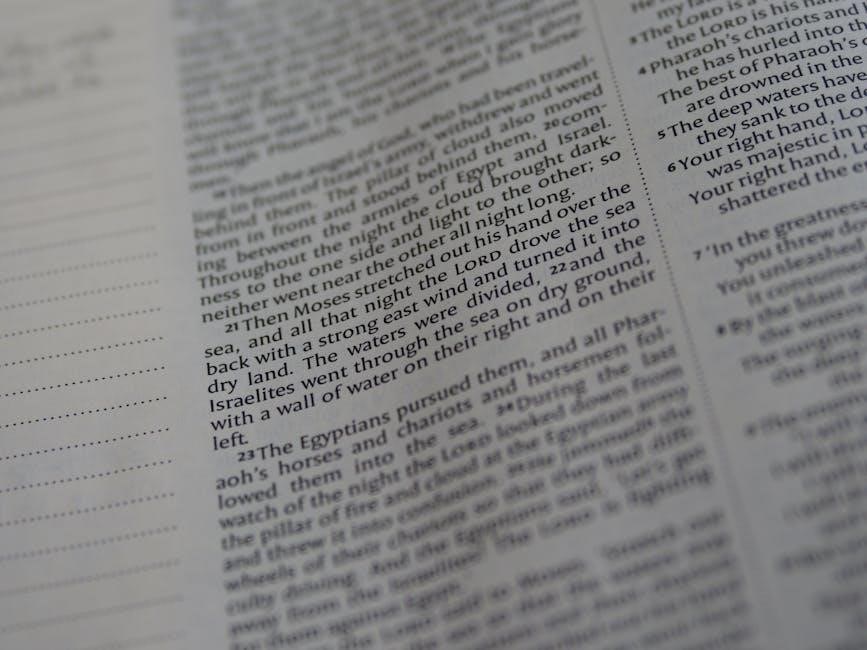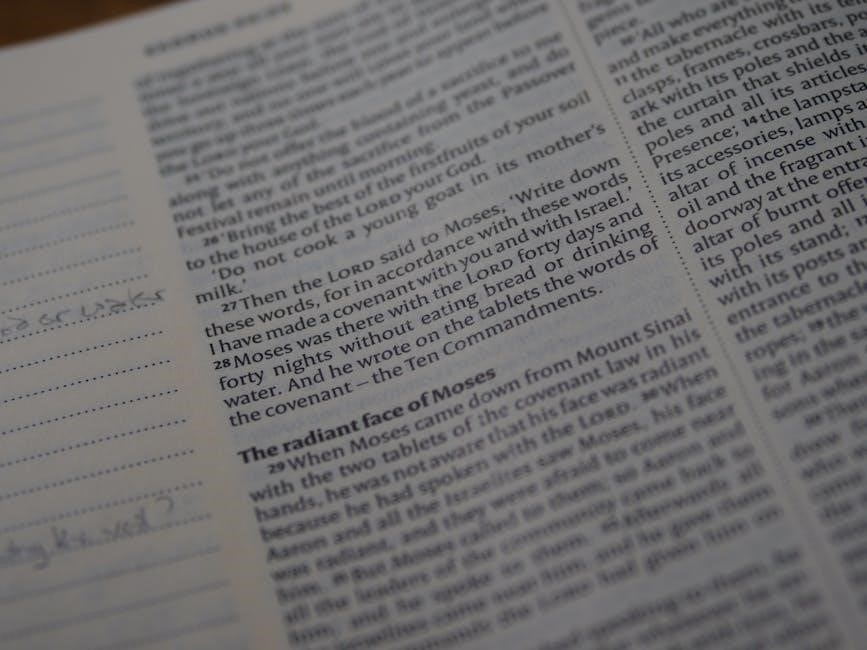The Book of Exodus‚ the second book of the Bible‚ recounts the Israelites’ journey from Egyptian slavery to freedom. Its title comes from the Greek word Exodos‚ meaning “departure.” Structured into two main parts‚ it details the exodus event and the giving of the Ten Commandments. Theologically‚ it emphasizes redemption‚ covenant‚ and worship. Available in PDF formats‚ Exodus study resources offer deeper insights into its historical and spiritual significance.
1.1. Historical Context of Exodus
The Book of Exodus is set against the backdrop of the Israelites’ enslavement in Egypt‚ spanning approximately 400 years. Following Joseph’s death‚ the Israelites grew from 70 individuals to a large nation‚ prompting Egyptian rulers to oppress them. The book begins with the Israelites’ suffering under Pharaoh‚ who forced them into labor and ordered the death of Hebrew male infants. This oppression set the stage for God’s intervention‚ leading to the Exodus event. Historical accounts suggest Moses emerged as the leader‚ guided by divine instructions‚ to confront Pharaoh and secure the Israelites’ freedom through miraculous events‚ including the Ten Plagues.
1.2. Significance of the Exodus Story
The Exodus story is a cornerstone of both Jewish and Christian traditions‚ symbolizing liberation and divine intervention. It highlights God’s faithfulness to His people and establishes the Israelites’ identity as a nation. The event underscores themes of redemption‚ freedom‚ and covenant‚ shaping theological frameworks. As a historical narrative‚ it showcases God’s power over human oppression‚ inspiring hope and resilience. The Exodus also serves as a universal symbol of deliverance‚ influencing social justice movements and religious thought. Its impact is profound‚ resonating in art‚ literature‚ and theology‚ making it a pivotal story in human history and spiritual reflection.
1.3. Structure of the Book of Exodus
The Book of Exodus is structured into two main parts: the exodus event and the covenant at Sinai. The first part (Chapters 1-18) details the Israelites’ oppression in Egypt‚ the ten plagues‚ the Passover‚ and the dramatic crossing of the Red Sea. The second part (Chapters 19-40) focuses on the giving of the Ten Commandments and the construction of the Tabernacle‚ symbolizing God’s presence among His people. This division underscores the transition from liberation to covenant life‚ emphasizing theological themes of redemption‚ worship‚ and divine guidance. The structure highlights the book’s dual focus on deliverance and the establishment of a sacred community.

The Exodus Event
The Exodus event recounts the Israelites’ miraculous departure from Egypt‚ led by Moses‚ marked by the ten plagues and the parting of the Red Sea‚ symbolizing divine liberation.
2.1. The Israelites in Egypt
The Israelites‚ initially welcomed in Egypt after Joseph’s rise‚ grew in number‚ becoming a threat to Pharaoh. They were termed Hebrews and subjected to forced labor. Their population surge alarmed Pharaoh‚ leading to oppressive measures‚ including the enslavement of Hebrew males. Despite harsh conditions‚ the Israelites endured‚ preserving their identity. Their cry for deliverance reached God‚ setting the stage for the Exodus. This period marked a transition from prosperity under Joseph to suffering‚ highlighting the themes of oppression and divine promise. The Israelites’ resilience amidst adversity laid the foundation for their eventual liberation under Moses’ leadership.
2.2. Moses as the Leader of the Exodus
Moses‚ despite initial reluctance‚ became the divinely appointed leader of the Israelites. Called by God through the burning bush‚ he confronted Pharaoh‚ demanding the Israelites’ release. His leadership was marked by faith‚ obedience‚ and humility. Moses faced challenges‚ including Pharaoh’s resistance and the people’s doubts‚ yet he remained steadfast. His role extended beyond liberation‚ as he guided the Israelites through the wilderness and received the Ten Commandments. Moses’ leadership symbolized God’s covenant promise‚ establishing him as a pivotal figure in Israel’s history and a model of divine appointment and trust in God’s plan.
2.3. The Ten Plagues and Pharaoh’s Resistance
The Ten Plagues were a series of divine judgments sent by God to compel Pharaoh to release the Israelites from bondage. They began with the Nile turning to blood and culminated in the death of the firstborn sons. Each plague targeted Egypt’s economy‚ environment‚ and people‚ showcasing God’s power. Despite the devastation‚ Pharaoh repeatedly hardened his heart‚ refusing to relent until the final plague. His resistance highlighted the themes of divine authority and human obstinacy‚ ultimately leading to the Israelites’ liberation. The plagues remains a central narrative in Exodus‚ emphasizing God’s sovereignty and justice.
2.4. The Passover and Its Symbolism
The Passover was a pivotal event in which God spared the Israelites from the tenth plague by having them mark their doorposts with the blood of a lamb. This act symbolized redemption and divine protection‚ as the angel of death “passed over” their homes. The Passover lamb represented innocence and sacrifice‚ prefiguring future redemption. The event became a perpetual commemoration‚ reinforcing Israel’s identity as a redeemed people. Its rituals‚ such as eating unleavened bread‚ symbolized urgency and liberation. The Passover deeply ingrained the themes of salvation and covenant‚ marking a cornerstone in Israel’s history and theological understanding.

Key Themes in Exodus
The Book of Exodus explores themes of redemption‚ covenant‚ and faith‚ highlighting God’s deliverance and relationship with Israel. These themes underscore divine sovereignty and human obedience.
3.1. Redemption and Freedom
The Exodus narrative vividly portrays redemption and freedom as central themes. God’s deliverance of the Israelites from Egyptian bondage exemplifies divine intervention and mercy. The Ten Plagues and the parting of the Red Sea symbolize God’s power and commitment to His people. Redemption is not merely physical liberation but also spiritual freedom from oppression. This theme has profound theological significance‚ reflecting God’s covenant love and His desire to form a holy nation. The Exodus story serves as a foundational metaphor for liberation in both Jewish and Christian traditions‚ inspiring hope and faith in divine deliverance.
3.2. God’s Covenant with the Israelites
The Book of Exodus emphasizes God’s covenant with the Israelites‚ establishing a sacred relationship. At Mount Sinai‚ God reveals His laws‚ including the Ten Commandments‚ to guide His people. This covenant is rooted in promises made to Abraham‚ Isaac‚ and Jacob‚ fulfilling His plan to create a holy nation. The covenant signifies mutual commitment: God promises protection and blessings‚ while the Israelites agree to obey His commands. This divine agreement forms the theological foundation of Exodus‚ shaping the Israelites’ identity and worship‚ and remains central to Jewish and Christian understanding of God’s relationship with humanity.
3.3. The Role of Faith and Obedience
Faith and obedience are central themes in Exodus‚ as the Israelites’ trust in God and adherence to His commands are repeatedly emphasized. Their journey from Egypt required unwavering faith‚ exemplified by their willingness to follow Moses into the unknown‚ even when faced with the Red Sea. Obedience to God’s laws‚ such as the Ten Commandments‚ was essential for maintaining their covenant relationship with Him. The construction of the Tabernacle and the observance of rituals further highlight the importance of obedience as an act of worship. Through these acts‚ the Israelites demonstrated their commitment to God’s will‚ reinforcing the bond between them and their divine deliverer.
Major Events in Exodus
Key events include the Burning Bush‚ the Ten Plagues‚ the parting of the Red Sea‚ the Passover‚ receiving the Ten Commandments‚ and constructing the Tabernacle.
4;1. The Burning Bush and Moses’ Calling
The Burning Bush marks Moses’ divine commission to lead Israel out of Egypt. While tending his father-in-law’s flock‚ Moses encountered a bush that burned without being consumed. God spoke from the bush‚ calling Moses to confront Pharaoh and free the Israelites. Reluctant at first‚ Moses questioned his ability but was assured of divine presence and given miracles to confirm his mission‚ such as his staff turning into a serpent and his hand becoming leprous. This event symbolizes God’s initiative in redemption and established Moses as a prophet and leader. It is a pivotal moment in Exodus‚ highlighting faith and obedience.
4.2. The Parting of the Red Sea
The parting of the Red Sea is a miraculous event in Exodus where God enabled the Israelites to escape Pharaoh’s pursuing army. Trapped between the sea and the advancing Egyptians‚ Moses‚ by God’s command‚ stretched his staff over the water. A strong east wind divided the sea‚ creating a dry path for the Israelites to cross safely. Once they reached the other side‚ the waters returned‚ engulfing Pharaoh’s army. This event symbolizes divine deliverance and redemption‚ cementing Israel’s faith in God. It remains a pivotal moment in biblical history‚ celebrated for its demonstration of God’s power and providence.
4.3. The Giving of the Ten Commandments
The giving of the Ten Commandments is a cornerstone event in Exodus‚ occurring after the Israelites reached Mount Sinai. God revealed Himself to Moses on the mountain‚ inscribing the Commandments on stone tablets. These commandments served as moral and legal guidelines for the Israelites‚ establishing principles for righteous living. The event marked a pivotal moment in God’s covenant with Israel‚ emphasizing obedience‚ worship‚ and ethical behavior. The Ten Commandments remain central to Jewish and Christian traditions‚ symbolizing God’s divine authority and enduring wisdom. This revelation solidified the foundation of Israel’s identity and faith‚ shaping their communal and spiritual life.
4.4. The Construction of the Tabernacle
The construction of the tabernacle‚ as detailed in Exodus‚ was a divine command given to Moses on Mount Sinai. God provided precise instructions for its design‚ emphasizing sacredness and symbolism. The tabernacle‚ a portable sanctuary‚ represented God’s presence among the Israelites. Bezalel‚ a skilled artisan‚ oversaw the project‚ crafting elements like the Ark of the Covenant and the altar. The structure included the Holy of Holies‚ the veil‚ and the priesthood area. This sanctuary served as a central place for worship and atonement‚ reinforcing God’s covenant with Israel. Its construction showcased communal dedication and obedience to divine will.

Profiles of Major Figures
The Book of Exodus highlights key figures like Moses‚ the leader of the Israelites‚ Pharaoh‚ the oppressive ruler‚ and Aaron‚ Moses’ brother and high priest. Their roles shaped the narrative of redemption and divine covenant‚ illustrating faith‚ leadership‚ and obedience to God’s will.
5.1. Moses: The Prophet and Leader
Moses‚ a central figure in Exodus‚ is portrayed as both a prophet and a leader. Born into a Hebrew family‚ he was raised in Pharaoh’s court but fled after killing an Egyptian. God called him through the burning bush to lead the Israelites out of Egypt. Moses confronts Pharaoh‚ orchestrates the Ten Plagues‚ and parts the Red Sea‚ showcasing his divine authority. He receives the Ten Commandments on Mount Sinai‚ establishing a covenant with God. His leadership‚ humility‚ and faith make him a pivotal figure in Israel’s history‚ symbolizing redemption and divine guidance.
5.2. Pharaoh: The Antagonist of the Exodus
Pharaoh‚ the ruler of Egypt‚ is the primary antagonist in the Exodus narrative. He stubbornly refuses to release the Israelites from slavery despite divine warnings and the devastating Ten Plagues. His hardened heart‚ whether self-inflicted or divinely ordained‚ leads to catastrophic consequences‚ culminating in the death of every firstborn son and the destruction of his army in the Red Sea. Pharaoh’s defiance symbolizes oppression and resistance to God’s will‚ making him a central figure in the story of liberation and divine judgment. His actions underscore the theme of redemption and the consequences of rejecting divine authority.
5.3. Aaron: The High Priest and Intercessor
Aaron‚ the brother of Moses‚ is appointed as the first high priest of the Israelites. He plays a crucial role in mediating between God and the people‚ conducting rituals‚ and offering sacrifices. Despite his divine appointment‚ Aaron faces challenges‚ such as the golden calf incident‚ where he succumbs to pressure from the people. His leadership highlights the complexities of human frailty and divine grace. Aaron’s legacy endures in Jewish tradition‚ symbolizing the priesthood and intercession. His story underscores the importance of spiritual leadership and the need for humility in serving God and His people.
Theological Significance of Exodus
The Book of Exodus underscores themes of redemption‚ covenant‚ and divine presence. It highlights God’s deliverance‚ the establishment of sacred rituals‚ and the tabernacle as a symbol of worship.
6.1. Exodus as a Foreshadowing of Christ
The Book of Exodus contains imagery and events that prefigure Christ’s mission. The Passover lamb‚ whose blood spared the Israelites‚ symbolizes Christ’s sacrifice for humanity. Moses‚ as a deliverer‚ foreshadows Christ’s role as the ultimate redeemer. The tabernacle’s design reflects heavenly worship‚ mirroring Christ’s mediation between God and humanity. These parallels emphasize Exodus’ theological depth‚ linking Israel’s liberation to Christ’s redemptive work‚ as highlighted in downloadable PDF commentaries and studies on Exodus.
6.2. The Concept of Atonement in Exodus
The Book of Exodus illustrates the concept of atonement through rituals and events symbolizing redemption. The Passover lamb’s blood‚ sprinkled on doorposts‚ protected the Israelites from judgment‚ prefiguring Christ’s atoning sacrifice. The parting of the Red Sea symbolized deliverance from sin’s bondage. The tabernacle’s sacrificial system‚ detailed in Exodus‚ emphasized the need for atonement through blood offerings‚ foreshadowing Christ’s role as the ultimate atonement. These themes highlight God’s plan for redemption‚ as explored in downloadable PDF commentaries and studies on Exodus.
6.3. The Role of the Tabernacle in Worship
The tabernacle in Exodus serves as a sacred space where God’s presence dwells among the Israelites. It symbolizes God’s desire to be with His people‚ emphasizing worship and communal devotion. The detailed instructions for its construction highlight its divine significance. The tabernacle’s design‚ including the Ark of the Covenant‚ represents God’s throne on earth. Rituals performed by priests within its precincts facilitate atonement and maintain covenant relationship. As a portable structure‚ it accompanies the Israelites‚ reinforcing God’s constant presence. The tabernacle’s role in worship underscores the importance of sacred space and ritual in sustaining spiritual connection‚ as detailed in Exodus PDF resources.

Cultural and Historical Impact
The Book of Exodus has profoundly shaped Jewish and Christian traditions‚ inspiring art‚ literature‚ and liberation movements. Its themes of freedom and redemption remain universally influential‚ as seen in Exodus PDF resources.
7.1. Exodus in Jewish Tradition
In Jewish tradition‚ the Exodus is a central narrative symbolizing liberation and divine redemption. It is commemorated during Passover‚ emphasizing freedom and God’s covenant with Israel. The story reinforces Jewish identity and faith‚ with the Exodus PDF resources offering detailed studies of its historical and theological significance. These resources highlight the Exodus as a foundational event in Jewish history‚ shaping rituals‚ laws‚ and communal memory. The Exodus story continues to inspire spiritual reflection and cultural practices‚ remaining a vital part of Jewish heritage and education.
7.2. Exodus in Christian Theology
The Exodus holds profound significance in Christian theology‚ often viewed as a foreshadowing of redemption through Jesus Christ. The Passover narrative parallels Christ’s sacrifice‚ with the lamb’s blood symbolizing salvation. The parting of the Red Sea is seen as a baptismal metaphor‚ representing spiritual rebirth. The Ten Commandments and the tabernacle prefigure Christ’s role as the ultimate covenant mediator. Exodus PDF resources explore these theological connections‚ emphasizing the Exodus as a foundational story of salvation history. It underscores God’s faithfulness and grace‚ linking Israel’s deliverance to humanity’s redemption through Christ.
7.3. Exodus in Art and Literature
The Exodus story has inspired countless works of art and literature throughout history. From dramatic biblical illustrations to modern reinterpretations‚ the event’s themes of liberation and divine intervention resonate deeply. Literary works often explore the Exodus as a metaphor for freedom and transformation. Artistic depictions frequently focus on iconic moments like the parting of the Red Sea and Moses receiving the Ten Commandments. PDF resources on Exodus highlight how these creative expressions enrich understanding of the narrative‚ bridging cultural and historical gaps. This rich legacy continues to influence contemporary art and literature‚ ensuring the Exodus remains a timeless and universal story.

Modern Interpretations and Applications
The Exodus story is often seen as a symbol of liberation‚ influencing modern theological thought and social justice movements. Its themes of freedom and redemption continue to inspire contemporary applications in advocacy and personal faith journeys‚ offering timeless relevance in today’s world.
8.1. Exodus as a Symbol of Liberation
The Exodus narrative serves as a powerful symbol of liberation‚ transcending its historical context. It embodies the universal struggle for freedom‚ inspiring movements worldwide. PDF resources highlight its relevance in modern theology‚ emphasizing themes of redemption and justice. The story’s enduring appeal lies in its ability to resonate with contemporary struggles‚ offering hope and resilience. Through its depiction of divine intervention and human courage‚ Exodus continues to symbolize the fight against oppression and the pursuit of freedom in various cultural and social contexts globally.
8.2. Exodus in Contemporary Theology
In contemporary theology‚ the Book of Exodus remains a vital text‚ offering insights into liberation‚ justice‚ and divine presence. Modern interpretations often emphasize its relevance to social justice movements‚ linking the Israelites’ liberation to struggles against oppression today. The concept of covenant and God’s commitment to the marginalized resonates deeply. PDF resources explore how Exodus themes‚ such as redemption and divine solidarity‚ inspire advocacy for human rights. Its narratives continue to shape theological discussions on freedom‚ ethical responsibility‚ and the pursuit of a just society‚ making Exodus a cornerstone of both historical and contemporary theological discourse.
8.3. Exodus and Social Justice Movements
The Exodus story has profoundly influenced social justice movements‚ symbolizing liberation from oppression. Modern movements draw parallels between the Israelites’ freedom and contemporary struggles for equality. The narrative inspires advocacy for the marginalized‚ emphasizing God’s commitment to justice. PDF resources highlight how Exodus themes‚ such as redemption and divine solidarity‚ fuel efforts to combat systemic inequality. The story’s universal message of liberation resonates across cultures‚ making it a powerful symbol in global struggles for human rights and freedom‚ connecting ancient history to modern activism.
Resources for Studying Exodus
Downloadable PDF versions of Exodus‚ commentaries‚ and study guides are widely available online‚ offering in-depth analysis and insights for both scholarly and personal study.
9.1. Commentaries on the Book of Exodus
Commentaries on the Book of Exodus provide insightful analyses of its historical and theological significance. The NETS translation‚ based on John William Wevers’ Greek text edition‚ offers a faithful rendering of Exodus. Downloadable PDF versions‚ such as those from the Companion Bible‚ include detailed commentaries and marginal references. These resources explore themes like redemption and covenant‚ aiding scholars and readers in understanding Exodus’ profound impact on Judeo-Christian traditions. Specific verses‚ such as Exodus 7:3‚ are analyzed to highlight God’s interaction with Pharaoh‚ enriching theological discussions.
9.2. Study Guides and Workbooks
Study guides and workbooks on Exodus are valuable tools for deepening understanding of the text. Many resources‚ such as the Workbook on Exodus by Padfield‚ offer detailed analyses and focused studies. Downloadable PDF versions provide accessible formats for personal or group study. These guides often include commentary‚ historical context‚ and theological insights‚ enabling readers to explore themes like redemption and covenant. Specific sections‚ such as the Companion Bible Condensed‚ offer marginal references and explanatory notes. These resources are designed to enhance comprehension and application of Exodus’ teachings in contemporary contexts‚ making them indispensable for scholars and lay readers alike.
9.3. Downloadable PDF Versions of Exodus
Downloadable PDF versions of the Book of Exodus are widely available‚ offering convenient access to the text. These PDFs can be sourced from reputable websites‚ such as Holy Bible KJV‚ and often include the full text of Exodus. Many versions are free to download‚ providing readers with flexible formats compatible with various devices. These resources are ideal for personal study‚ group discussions‚ or academic research. Additionally‚ some PDFs include commentary and study aids‚ enhancing understanding. Downloadable Exodus PDFs are a valuable tool for exploring the narrative‚ themes‚ and theological significance of the book in a modern‚ accessible way.




About the author